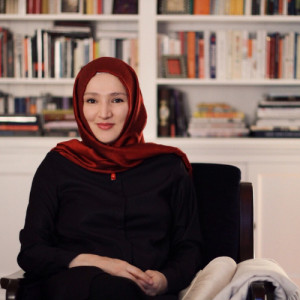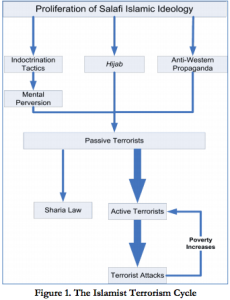 A policy paper issued by the Air Force Research Laboratory, titled Countering Violent Extremism: Scientific Methods & Strategies, includes a chapter setting forth controversial and unsubstantiated theories of radicalization, including the idea that support for militant groups is driven by “sexual deprivation” and that headscarves worn by Muslim women represent a form of “passive terrorism.”
A policy paper issued by the Air Force Research Laboratory, titled Countering Violent Extremism: Scientific Methods & Strategies, includes a chapter setting forth controversial and unsubstantiated theories of radicalization, including the idea that support for militant groups is driven by “sexual deprivation” and that headscarves worn by Muslim women represent a form of “passive terrorism.”
The paper, first published in 2011, was reissued by the Air Force lab this past summer following President Obama’s announcement of a national counter-extremism strategy. This January, the revised copy was published online by the open source research website Public Intelligence. A preface for the revised report cites a summit convened by Obama on extremism as a reason for revisiting the subject, adding that “the wisdom contained in this paper collection is more relevant than ever.”
Many of the articles contained in the document have scholarly merit and are written by academics and researchers in the field of counterterrorism. But a chapter titled “A Strategic Plan to Defeat Radical Islam,” written by Dr. Tawfik Hamid, a self-described former Islamic extremist and fellow at the Potomac Institute for Policy Studies, contains a number of bizarre prescriptions for how to defeat terrorism, few of which appear to be supported by empirical evidence
 Among Hamid’s claims are that support for militancy is primarily a product of sexual deprivation and that terrorism bears relation to religious dress. His ideas for combating terrorism thus include “addressing the factors underlying [sexual] deprivation” among young men, as well as “weakening the hijab phenomenon.” Hamid further claims that, along with fundamentalist ideology, the “hijab contribute[s] to the idea of passive terrorism” and represents an implicit refusal to “speak against or actively resist terrorism.”
Among Hamid’s claims are that support for militancy is primarily a product of sexual deprivation and that terrorism bears relation to religious dress. His ideas for combating terrorism thus include “addressing the factors underlying [sexual] deprivation” among young men, as well as “weakening the hijab phenomenon.” Hamid further claims that, along with fundamentalist ideology, the “hijab contribute[s] to the idea of passive terrorism” and represents an implicit refusal to “speak against or actively resist terrorism.”
Hamid does not make clear how he reaches these conclusions. On his personal website, he describes himself as “an Islamic thinker and reformer” and says he has a medical degree in internal medicine from Cairo University and a master’s degree in cognitive psychology and educational techniques from the University of Auckland. He also claims credit “for developing one of the most innovative Cognitive Psychology models, the Multi-Dimensional Learning Model.”
Unsubstantiated assertions
Two terrorism experts and a professor of Islamic Studies questioned the assertions in Hamid’s chapter of the Air Force white paper, calling them unsubstantiated.
“This characterization of the hijab demonizes millions of women whose reasons for covering have nothing to do with the advocacy of political violence,” says Arun Kundnani, a lecturer on terrorism studies at New York University. “The document as a whole includes some scholars who are serious researchers. However it appears the purpose of this chapter by Hamid is not a genuine investigation of the roots of violence, but rather an attempt to supply national security agencies with bogus surveillance rubrics.”
Hamid’s theory of radicalization states that terrorism stems from a lack of sexual activity among young men and that addressing this issue is key to reducing support for militant groups. “I believe young Muslims are motivated to join radical groups because of sexual deprivation,” he writes, claiming further that “addressing the factors causing deprivation in this life can interrupt the radicalization process and reduce the number of suicide attacks by jihadists.”
An expert on the subject of foreign fighters disagrees. “There is virtually no evidence that sexual deprivation is somehow a cause of radicalization, or suicide attacks,” says Amarnath Amarasingam, a fellow at George Washington University’s Program on Extremism. “From my interviews with jihadists in various organizations, it is clear that they are there for a complex variety of reasons. To simply attribute their motivations to sexual depravity is to miss the point entirely.”















No Comments